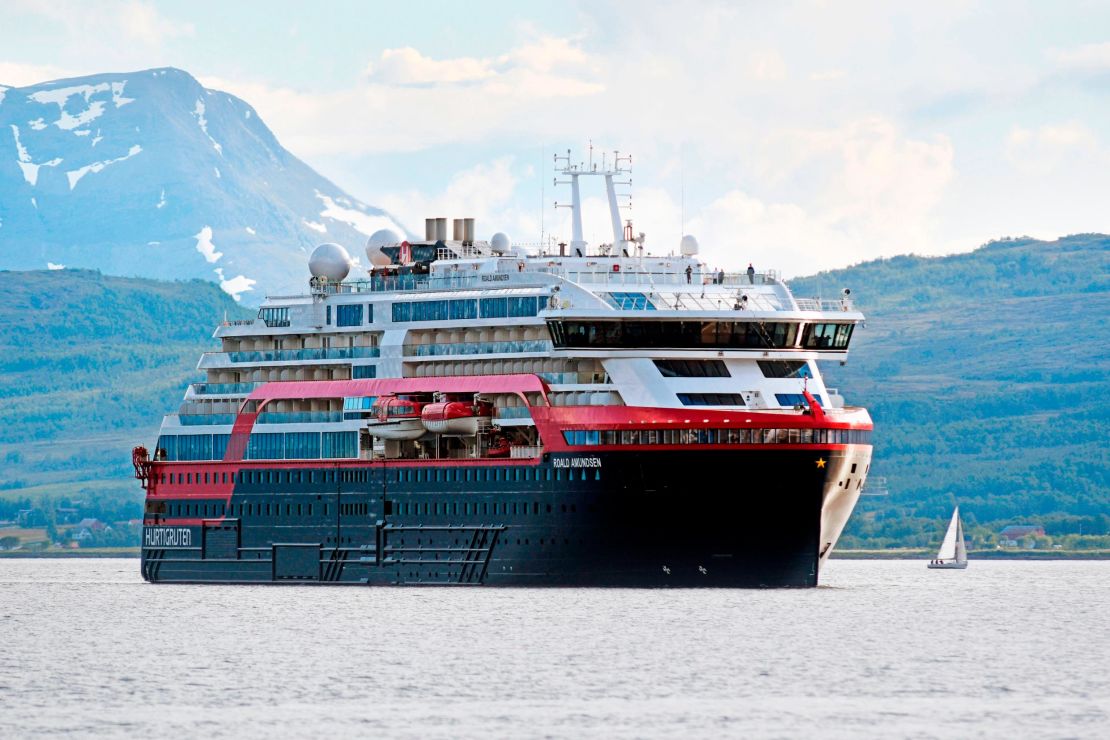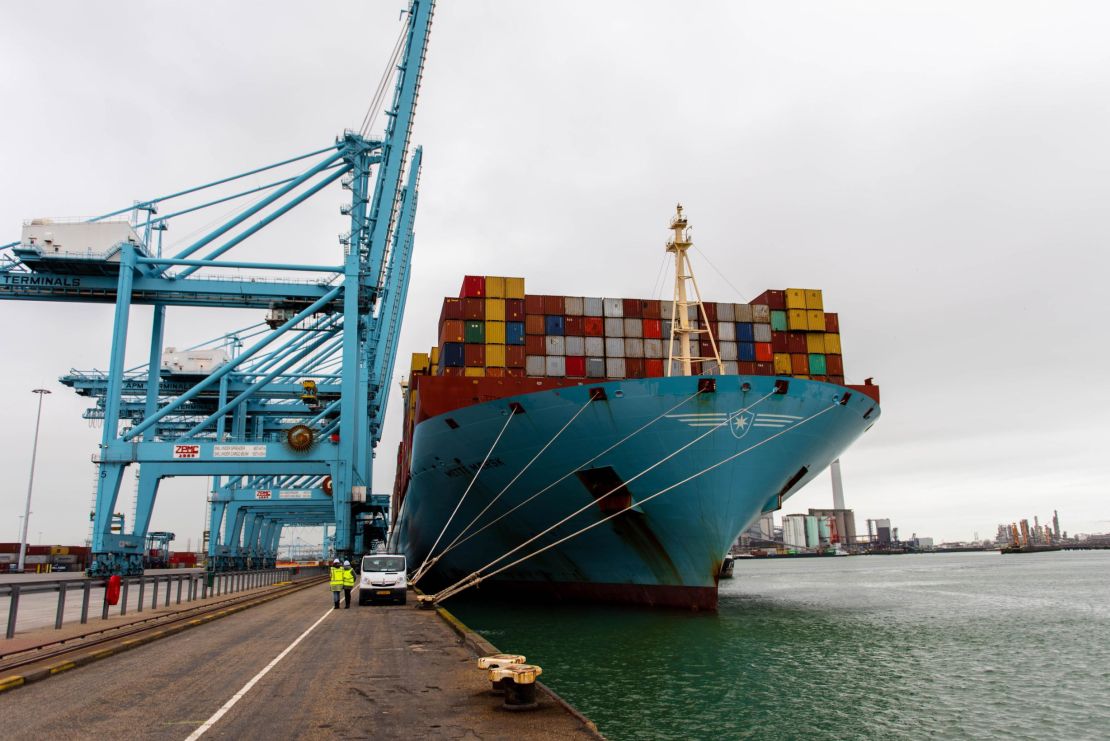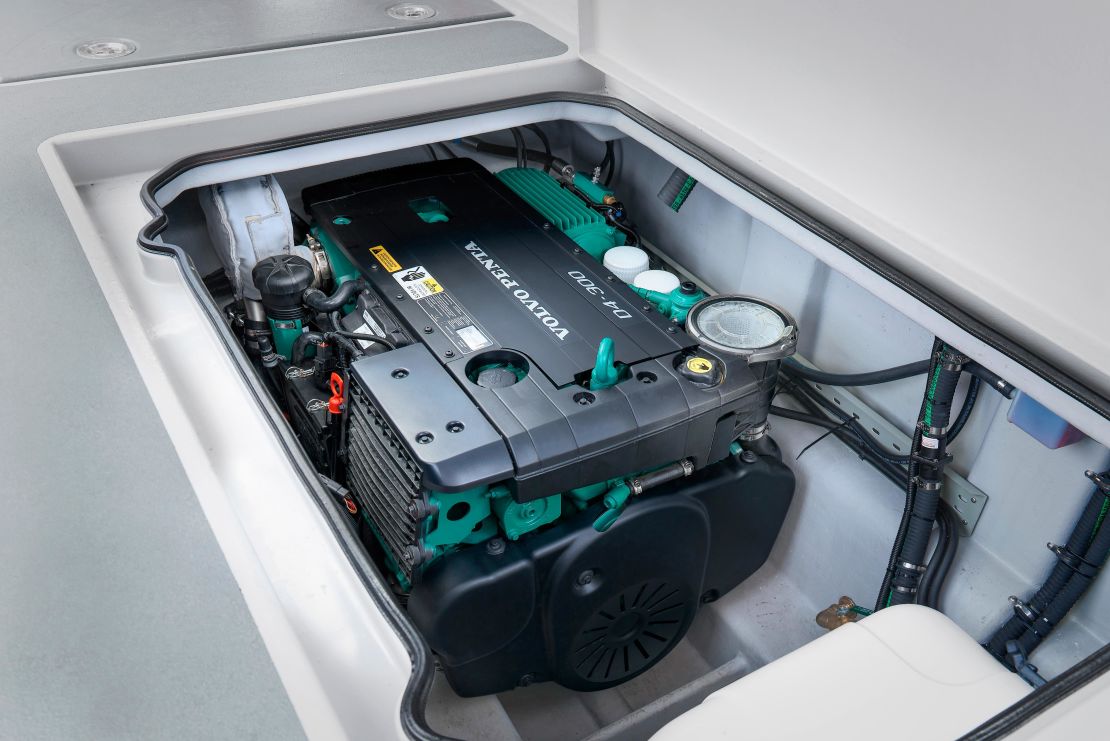In the port of Antwerp in Belgium, a small boat whizzes around, shuttling 16 passengers back and forth. The “Hydroville” is fast, silent and, most strikingly, it produces zero pollution.
Built by Compagnie Maritime Belge (CMB), it’s the world’s first sea-faring vessel to burn hydrogen in a diesel engine. No carbon dioxide or sulfur oxides are released during the process. The ship produces some nitrogen oxide, but that’s converted into harmless nitrogen and water by a catalyst. In one of the dirtiest industries in the world, it’s a tantalizing glimpse of a cleaner future.
Owned by one of Belgium’s oldest shipping families, CMB and its small boat are leading the way as the shipping industry tries to tackle its contribution to the climate crisis. “Green hydrogen-based fuels are the only zero-emission solution in the long run,” CMB CEO Alexander Saverys told CNN Business.

As bad as aviation
The United Nations warned in 2018that the world had 12 years to stem catastrophic levels of global warming, piling the pressure on international shipping to clean up its act. Ships areincredibly polluting, belching out millions of tons of greenhouse gases every year. They emit sulfur dioxide, a pollutant linked to respiratory illnesses, as well as carbon dioxide and methane, gases which cause global warming by trapping heat in the atmosphere.
Maritime emissions account for around 3% of global carbon dioxide output, roughly the same as aviation. According to the World Economic Forum, if shipping was a country, it would be the sixth-largest polluter in the world. And if unchecked, the problem is only going to get much worse.Ships transport over 90% of goods that are traded and the industry has been growing rapidly. By the middle of this century, the International Maritime Organization (IMO) projects that emissions will grow by between 50% and 250% if vessels continue to burn fossil fuels. That would leave shipping producing as much as 17% of global carbon dioxide emissions in 2050.
While the industry was excluded from the 2015 Paris Climate Agreement because its emissions are hard to allocate to individual countries, the international community has started to act. Under pressure from island states threatened byrising sea levels, the IMO — a UN body that regulates shipping — set a target last year of slashing emissions by at least 50% by 2050, compared to 2008. But achieving this ambitious goal requires ship owners to move away from fossil fuels and invest in cleaner technology, much of which has never been used on large vessels before.
The challenge is particularly acute because the choices shipping companies make now will play out over the next 30 years. “We’re building the ships today which will be in operation over the next three decades,” Dr. Tristan Smith, an expert in shipping and energy at University College London’s (UCL) Energy Institute, said in an interview with CNN Business. To stand any chance of meeting the IMO target, zero emissions vessels need to enter the fleet by 2030 at the latest, he added.
Little headway
Since the IMO set its target, many of the world’s largest shipping companies have made ambitious pledges to slash their emissions over the next three decades. For some, the first step was simple — reduce the speed at which their fleets ply the oceans. That has already resulted in emissions being cut by as much as 30%, according to a report by the Carbon Disclosure Project (CDP), which ranksthe sustainability efforts of the world’s largest operators.
But sailing more slowly is only a short-term fix that won’t do enough to hit the IMO target, according to CDP. Success requires new ships, new engines and new fuels. Major financial, regulatory and technical barriers have to be overcome, and so far much of the shipping industry is dragging its feet when it comes to innovation.“Shipping companies are failing to push for the critical technologies required to reduce their carbon footprint,” according to CDP. Just three of the 18 companies CDP ranked have a committee at board level responsible for tackling the climate emergency.
One of the frontrunners is Maersk, the world’s largest container shipping company with $39 billion in revenue last year. It has pledged to become fully carbon neutral by 2050 and has invested $1 billion since 2014 in energy efficient technodoelogy. The company’s head of sustainability, John Kornerup, told CNN Business that by 2030 Maersk intends to reduce emissions by 60%. “If we want to be ready in 10 years, we need to get started now,” he said. Maersk is running trials with different fuels and also developing electric batteries. Decarbonizing shipping requires “a completely new propulsion technology,” Kornerup added. But even Maersk, with its financial firepower, says it cannot make zero-carbon ships a reality without industry collaboration.
The Mette Maersk, powered by an oil and biofuel blend, arrives in Hong Kong — Credit: Maersk
It’s an approach CMB has already adopted. The company, which has won multiple sustainability awards since it was bought by the Saverys family in 2015, recently announced a partnership with Japan’s Tsuneishi Facilities and Craft to build the world’s first ferry that can run on hydrogen and diesel by 2021. CMB’s strategy is about testing low-carbon technologies on smaller ships, such as the Hydroville, and then scaling them up. “The Hydroville is a small project which aims 10 years ahead of its time,” Roy Campe, CMB’s research and development manager, told CNN Business.
The Hydroville is “a splendid example of how a commercially-driven project can offer high sustainability gains,” Antwerp Port Authority CEO Jacques Vandermeiren said last year. CMB plans to launch a hydrogen engine next year that can power larger vessels such as tugboats and barges. And it’s hoping to launch the world’s first hydrogen-powered container shipsin the next decade. As a family-run business which was taken private in 2015, CMB is less constrained by shareholders than public companies such as Maersk. “Coming up with new technologies involves risks and that is why there is almost no innovation,” Campe said.
Cleaner cruising?
Norwegian cruise liner Hurtigruten is pursuing different technology.It has just launched the world’s first hybrid cruise ship. Powered by a combination of batteries and marine gas oil, the Roald Amundsen sailed from Tromso to Hamburgin July, producing 20% fewer emissions than other ships of the same size, according to Daniel Skjeldam, Hurtigruten’s CEO.
“To operate sustainably, you have to invest in new technology. This is a new green revolution that’s coming,” said Skjeldam, adding that the cruise sector has been lagging other industries when it comes to cutting emissions.

The cruise industry grew by almost 50% between 2010-2018 and the number of passengers increases by 4-6% each year, according to Cruise Lines International Association.
An undercover investigation by Johns Hopkins University this year found that cruise ships generate dangerous levels of air pollution. And the world’s largest cruise operator, Carnival, emitted almost 10 times more sulfur oxide — a highly toxic gas — than all 260 million cars in Europe in 2017, according to a review by non-profit Transport and Environment in June. A Carnival spokesperson told CNN the report was based on “outdated numbers and differs dramatically from fuel data and emissions tracked on Carnival Corporation (CCL)’s vessels.”
Despite the trials of new technology by companies such as Maersk, Hurtigruten and CMB, industry-wide progress is too slow. Big companies are hesitant to invest billions of dollars in new technology and there are few financial incentives and regulations in place to push them to do so. But experts say it is crucial that the industry does not wait to be forced to act.
“The cruise industry should be front runners in introducing new technology and reducing emissions. We simply cannot wait for regulations,” Skjeldam said.
Burning dead fish
The biggest challenge for the shipping industry is moving away from heavy fuel oil, a type of diesel used by most of the world’s tankers and cargo ships. Battery technology is powering the clean vehicle revolution on land. But fully electric ships are unlikely to be sailing the seas by 2050. Electric batteries cannot store enough energy to propel deep sea vessels traveling long distances, experts say. Low carbon fuel may be the answer, UCL’s Smith said.
Many companies are focusing on liquified natural gas (LNG) and biofuels as alternatives. By 2021, Hurtigruten aims to operate a fully hybrid fleet, retrofitting all its 16 ships with a combination of LNG, batteries and biogas. “Almost half our fleet will be literally powered by nature, as we will replace engines with batteries, natural gas and biogas — made from organic waste such as dead fish,” Skjeldam said.
The batteries on board the Roald Amundsen kick in whenever there is a surge in energy demand, Skjeldam explained. “We use the batteries to take care of these peaks. When the engines produce excess energy, this is transferred into the batteries. This secures smooth and optimal running of the engines at all time, significantly reducing fuel consumption and emissions,” he said. “LNG is substantially less polluting than conventional diesel fuel and utilizing LNG as a component in different hybrid set-ups is a major step towards achieving Hurtigruten’s ultimate ambition of sailing emission free,” he added.
Royal Dutch Shell (RDSA) already operates one of the largest LNG fleets in the world, managing over 40 carriers powered by the natural gas. But LNG has significant drawbacks and experts say it is not a viable long-term solution. It may be less toxic than diesel, but its primary component is methane — a gas that is roughly 30 times more potent at trapping heat in the atmosphere than carbon dioxide.
Biofuel is a better alternative as far as Maersk is concerned. The company recently used a blend of fuels produced from plant waste to help power a container ship traveling from Rotterdam to Shanghai. By using the fuel mix — 20% biofuels and 80% fuel oil — Maersk reduced the vessel’s CO2 emissions by 85% or 1,500 tons, the equivalent of what 200 households produce each year. “It’s the only option for now,” Kornerup told CNN Business.

Still, even that has its problems. Using biofuels for shipping is “a wasted opportunity to store CO2 and is only viable in very limited quantities,” according to Smith at UCL. Using land to generate solar power is about eight times more efficient than biofuel production, he noted. According to a report from the International Panel on Climate Change (IPCC), mass adoption of biofuels is not the answer. Scientists say that ramping up their production would lead to a huge spike in global food pricesas agricultural land is diverted.
“The biggest pitfalls are biofuels, which can’t be scaled or enforced sustainably, especially in shipping. LNG and synthetic methane are other dead ends due to methane leakage and enforcement problems,” Transport and Environment concluded in its 2018 report, ‘Roadmap to Decarbonising European Shipping.’
The challenge of hydrogen
Hydrogen is one of the most promising solutions for companies looking to meet the IMO target as it is clean and suitable for all ship sizes. But this fuel also presents challenges. “The storage of hydrogen is probably the biggest stumbling block. Compressed hydrogen takes 15 times more space compared to diesel for the same amount of energy,” CMB CEO Saverys said.
Experts say companies should make the huge leap towards decarbonization by investing in dual combustion systems, which use a combination of diesel and low-carbon fuels, such as hydrogen, or batteries. “At the moment the cheapest way to operate is to continue using an internal combustion engine [which runs on diesel] and liquid fuel like hydrogen or ammonia that you have produced using renewable energy,” according to Smith.
Blending fuel is at the heart of CMB’s strategy. “Our diesel-hydrogen engines are a natural transition towards hydrogen. Diesel can still be burnt as principal fuel (in case no hydrogen is available), which gives users peace of mind to adopt this new technology,” Saverys said.

More companies should adopt transitional solutions, according to CDP. In its report, Carole Ferguson, head of investment research, said companies should focus on “step change innovations.” “There are no zero carbon technologies that you can apply on ships today that are viable,” said Kornerup. “But we simply need to speed up [innovation] because we only have 11 years.”
The biggest barrier to achieving low-carbon shipping is cost. Hydrogen and other low-carbon fuels are much more expensive than diesel. A hydrogen-powered ship costs around $10-$15 millionmore to build than a diesel vessel,and the investment is hard to justify given the lack of incentives or regulation, according to Saverys.
“The technology is already here,” said Smith. “What’s lacking is the impetus.”





















